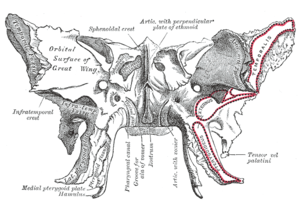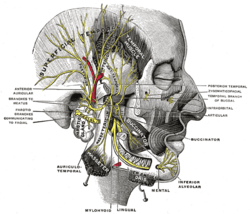Temporal muscle
| Temporal muscle | |
|---|---|
 | |
| The Temporalis; the zygomatic arch and Masseter have been removed. | |
| Latin | Musculus temporalis |
| Origin | Temporal lines on the parietal bone of the skull. |
| Insertion | Coronoid process of the mandible. |
| Artery | Deep temporal arteries |
| Nerve | Deep temporal nerves, branch(es) of the anterior division of the mandibular nerve (V3) |
| Actions | Elevation and retraction of mandible |
| Antagonist | Platysma muscle |
The temporal muscle, also known as the temporalis, is one of the muscles of mastication. It is a broad, fan-shaped muscle on each side of the head that fills the temporal fossa, superior to the zygomatic arch so it covers much of the temporal bone. [1]
Structure
In humans, it arises from the temporal fossa and the deep part of temporal fascia. It passes medial to the zygomatic arch and inserts onto the coronoid process of the mandible, with its insertion extending into the retromolar fossa posterior to the most distal mandibular molar. [2] In other mammals, the muscle usually spans the dorsal part of the skull all the way up to the medial line. There, it may be attached to a sagittal crest, as can be seen in early hominins like Paranthropus aethiopicus.
The temporal muscle is covered by the temporal fascia, also known as the temporal aponeurosis.
The muscle is accessible on the temples, and can be seen and felt contracting while the jaw is clenching and unclenching.
Embryology
The temporalis is derived from the first pharyngeal arch in development.
Innervation
As with the other muscles of mastication, control of the temporal muscle comes from the third (mandibular) branch of the trigeminal nerve. Specifically, the muscle is innervated by the deep temporal nerves.
Blood supply
The muscle receives its blood supply from the deep temporal arteries which anastomose with the middle temporal artery.
Actions
If the entire muscle contracts,the main action is to elevate the mandible, raising the lower jaw. Elevation of the mandible occurs during the closing of the jaws. If only the posterior part contracts, the muscle moves the lower jaw backward. Moving the lower jaw backward causes retraction of the mandible. Retraction of the jaw often accompanies the closing of the jaws. [1]
When lower dentures are fitted, they should not extend into the retromolar fossa to prevent trauma of the mucosa due to the contraction of the temporalis muscle. [2]
Additional images
-

Temporal muscle (red).
-

Muscles of head and neck
-

Frontal bone. Outer surface.
-

Sphenoid bone. Anterior and inferior surfaces.
-

Mandible. Outer surface. Side view.
-

Mandible. Inner surface. Side view.
-

Mandibular division of the trifacial nerve.
-
Temporal muscle.Deep dissection.Mummification proces.
-
Temporal muscle.Deep dissection.Mummification proces.
| Dissection images |
|---|
|
References
- ↑ 1.0 1.1 Illustrated Anatomy of the Head and Neck, Fehrenbach and Herring, Elsevier, 2012, page 98
- ↑ 2.0 2.1 Human Anatomy, Jacobs, Elsevier, 2008, page 194
External links
| Wikimedia Commons has media related to Temporal muscles. |
- LUC temp
- 27:04-0100 at the SUNY Downstate Medical Center - "Infratemporal Fossa: The Temporalis Muscle"
- The anatomical basis for surgical preservation of temporal muscle, Kadri, et al, J Neurosurg 2004, 100:517–522 at http://www.mc.vanderbilt.edu/documents/singerlab/files/Kadri%20et%20al.pdf
- Temporalis Muscle Transfer, The Methodist Hospital System, Houston, TX, at http://www.methodistfacialparalysis.com/temporalis/
| |||||||||||||||||||||||||||||||||








